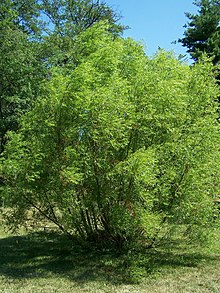Black willow
| Salix nigra | |
|---|---|
 |
|
| In the Morton Arboretum | |
| Scientific classification | |
| Kingdom: | Plantae |
| (unranked): | Angiosperms |
| (unranked): | Eudicots |
| (unranked): | Rosids |
| Order: | Malpighiales |
| Family: | Salicaceae |
| Genus: | Salix |
| Species: | S. nigra |
| Binomial name | |
|
Salix nigra Marshall |
|
 |
|
| Natural range | |
Salix nigra (black willow) is a species of willow native to eastern North America, from New Brunswick and southern Ontario west to Minnesota, and south to northern Florida and Texas.
It is a medium-sized deciduous tree, the largest North American species of willow, growing to 10–30 m (35–100 ft) tall, exceptionally up to 45 m (148 ft), with a trunk 50–80 centimeters (20–30 in) diameter. The bark is dark brown to blackish, becoming fissured in older trees, and frequently forking near the base. The shoots are slender and variable in color from green to brown, yellow or purplish; they are (like the related European Salix fragilis) brittle at the base, snapping evenly at the branch junction if bent sharply. The foliage buds are 2–4 millimetres (1⁄16–3⁄16 in) long, with a single, pointed reddish-brown bud scale. The leaves are alternate, long, thin, 5–15 centimeters (2–6 in) long and 0.5–2 centimeters (1⁄4–3⁄4 in) broad, usually somewhat falcate, dark, shiny green on both sides or with a lighter green underside, with a finely serrated margin, a short petiole and a pair of small stipules. It is dioecious, with small, greenish yellow to yellow flowers borne on catkins 2.5–7.5 centimeters (1–3 in) long in early spring at the same time as the new leaves appear. The fruit is a 5 millimeters (3⁄16 in) capsule which splits open when mature to release the numerous minute, down-covered seeds. The leaves turn a lemon yellow in the fall. It is typically found along streams and in swamps.
...
Wikipedia

